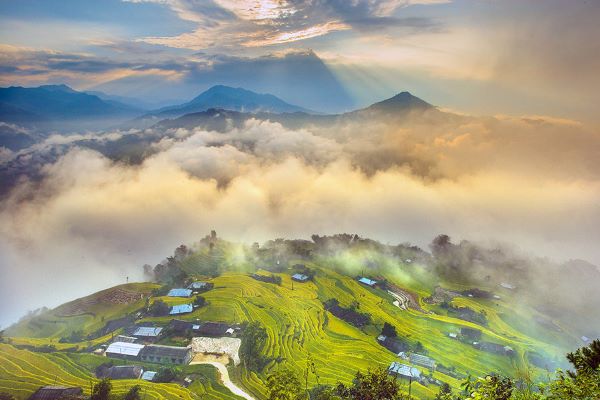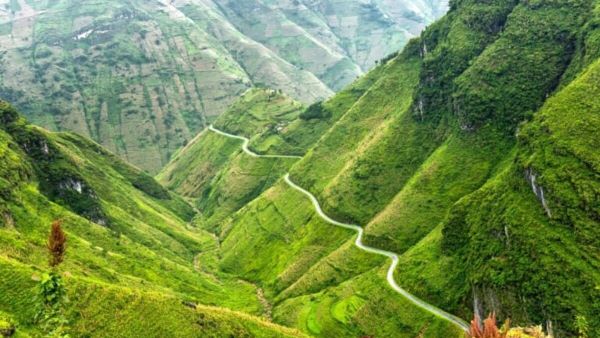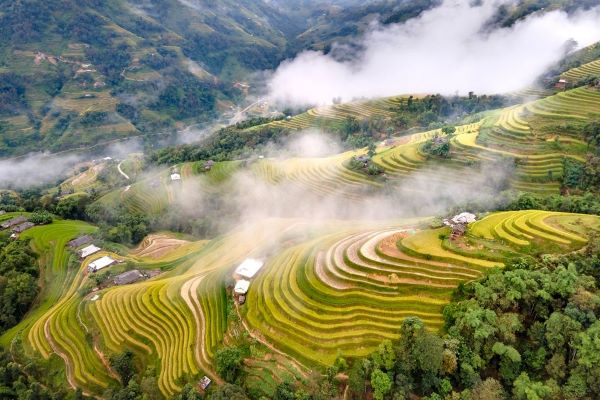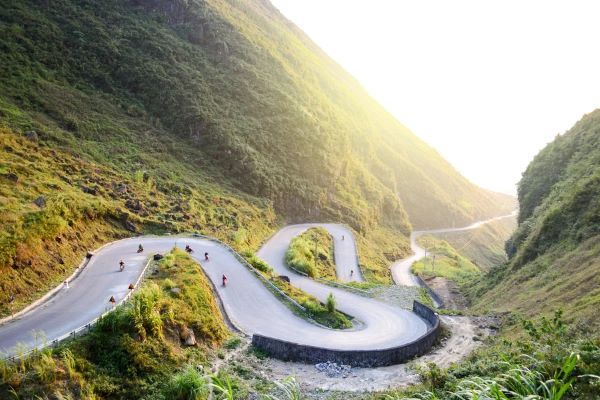Planning a trip to Ha Giang? Understanding Ha Giang weather is key to making the most of your adventure! This northern gem of Vietnam offers breathtaking landscapes that change dramatically with the seasons. Whether you’re chasing golden rice terraces in autumn, blooming flowers in spring, or misty mountain roads in winter, each season brings a unique experience. Let’s dive into the best times to visit and what to expect throughout the year!

Ha Giang shines in every season discover the best time for your dream adventure
Weather, climate & seasons of Ha Giang
Ha Giang’s climate is welcoming year-round, making it an ideal destination no matter when you go. However, the region experiences two distinct seasons:
- Rainy Season (Mid-September – Early May): Expect occasional showers, especially in higher-altitude areas where rain may start as early as mid-August.
- Dry Season (Early May – Mid-September): Warmer and sunnier, perfect for outdoor exploration.

Discover the best time to visit for your perfect adventure
Ideal Travel Windows:
For the most pleasant weather, plan your trip between September–November or March–May, when temperatures hover around a comfortable mid-20s°C. If visiting in summer, be prepared for heat and humidity, especially in the valleys where temperatures can exceed 30°C. In contrast, winter (December–February) can be quite cold, with rare instances of light snowfall so pack warm clothing.
If you want to avoid crowds:
Steer clear of October and November, as these months attract a large number of domestic tourists. Accommodations and tours fill up quickly and may be more expensive.
When’s the best time to visit Ha Giang?
Ha Giang is beautiful year-round, with its landscapes transforming dramatically across the seasons. Located in northern Vietnam, this mountainous region experiences two distinct seasons: dry and rainy. However, the weather can vary significantly depending on the month and altitude, as much of the Ha Giang Loop winds through highlands and rugged terrains.
This guide will help you understand Ha Giang Loop weather throughout the year so you can choose the best time for your journey and be fully prepared for an unforgettable adventure.

Ha Giang offers breathtaking beauty in every season discover the best time to explore its stunning landscapes and unique weather conditions
January – March: Spring Awakens with Blooming Flowers
As early as January, Ha Giang bursts into color with peach blossoms, plum flowers, and golden rapeseed fields painting the rugged landscape. By February, visitors flock to the region to witness this breathtaking floral display.
Weather: This period marks the dry season, with minimal rainfall and plenty of sunshine ideal for exploring the loop safely.
Temperature: January (17°C), February (18°C), and March (19°C). While pleasant for trekking, the chill on a motorbike ride can be biting, so pack warm layers.
Special Event: If you visit between late January and early February, you’ll experience Tet (Vietnamese Lunar New Year), Vietnam’s most important festival, with vibrant local celebrations.
April – May: Warm and Pleasant with Stunning Reflections
April is one of the best months to visit, with clear blue skies, mild temperatures (24°C), and fewer crowds. As May arrives, rice farmers begin irrigating their fields, turning Ha Giang’s terraces into mesmerizing water mirrors.
Temperature: April (24°C), May (up to 29°C).
Rain: May marks the beginning of the rainy season, so expect occasional showers refreshing breaks from the heat.
June – August: Hot and Rainy with Lush Greenery
Summertime in Ha Giang means heat, humidity, and heavy rains. Expect temperatures around 30°C, frequent thunderstorms, and slippery roads. While the landscapes are lush and green, this season requires extra caution on the loop.
Tips: Stay hydrated, wear light clothing, and embrace the cool breeze while riding.
September – October: The Golden Season of Rice Terraces
As autumn arrives, Ha Giang transforms into a golden wonderland. Between late September and early October, rice terraces ripen, creating breathtaking landscapes that make this one of the most photogenic times to visit.
Temperature: September (28°C), October (27°C).
Rain: Expect some showers, but much less than in the summer months.
Highlight: This is peak season for photography lovers—don’t miss the golden fields at their prime.
November: Buckwheat Blossoms and Cool Comfort
November is flower season. The hills of Ha Giang are covered in delicate pink and violet buckwheat flowers, creating dreamy scenery for nature lovers and photographers alike.
Temperature: 24°C in Ha Giang City, but in the highlands, evenings can drop to 10°C or lower.
Rainfall: Minimal, making this one of the most comfortable months to visit.
December: Cool, and Dry Possibly Snowy
December brings crisp air, dry skies, and cool temperatures. In Ha Giang City, expect around 19°C, but along the loop, daytime temperatures drop to 15°C, and nights can plunge to 5–10°C. In higher elevations like Meo Vac, you might even witness snow.
Tip: Pack warm clothing and prepare for chilly nights.
Final Thoughts: When Should You Visit?
- Spring (Jan–Mar) – Best for flower lovers and mild trekking weather.
- Summer (Jun–Aug) – Lush greenery but hot and rainy.
- Autumn (Sep–Oct) – The best time for golden rice terraces.
- November – Beautiful buckwheat flower season.
- Winter (Dec) – Crisp air, dry roads, and potential snow.
If you’re planning to experience the weather Ha Giang Loop at its best, consider autumn for its golden rice terraces or spring for its vibrant flowers!
How to get to Ha Giang
Hà Giang, with its breathtaking landscapes and winding mountain roads, is a must-visit destination for adventure seekers. If you’re planning a trip, here’s how to get there and explore the region efficiently.
From Ha Noi
Hà Giang is about 300 km from Ha Noi, and there are several ways to get there:
- By Bus: Sleeper buses to Hà Giang depart daily from My Đình Bus Station, taking 6-8 hours. You can book a bus through Hà Giang City Hostel – Hotline: 0945.49.69.96
- By Motorbike: A great choice for adventurous travelers who want to enjoy the scenic route. The journey takes 8-10 hours, and it’s essential to have good riding skills and a well-maintained motorbike.
- By Private Car: A faster and more comfortable option, taking about 5 hours, depending on traffic.
At Ha Giang
Once in Hà Giang, you have several transportation options to explore the region:
- Motorbike Rental: The best way to explore Dong Van, Meo Vac, Ma Pi Leng Pass, Quan Ba Heaven Gate and other attractions. Rental prices range from 200,000 to 550,000 depending on the type of motorbike. Some notable motorbike rental services: Ha Giang City Hostel
- Taxis and Motorbike Taxis: Available in Hà Giang City but less common in remote areas. Always agree on the fare before starting the trip.
- Tour Services: If you prefer a well-planned trip, guided tours offer transportation, accommodation, and a guide, making it easier to explore the area without worrying about logistics.
For more details on routes and must-visit destinations, consider checking specific guides for each region in Hà Giang.
Tips for your best experience in Ha Giang, Vietnam

Essential tips to make the most of your Ha Giang adventure, from weather planning to local insights
Do:
- Embrace cultural diversity: Ha Giang is home to many ethnic groups. Learn about their traditions at the Museum of Ethnology in Hanoi before your trip, and always show respect. Ask for permission before taking photos of locals.
- Pack smart: Bring versatile clothing for both warm and cool weather. Essentials include comfortable walking shoes or hiking boots, sunscreen, insect repellent, a rain jacket, and a sleeping bag liner for chilly nights or musty bedding.
- Drive with caution: Ha Giang’s winding mountain roads can be treacherous. Always wear a helmet, check your rented motorbike for safety features (e.g., rearview mirrors), and ensure you have a valid license.
- Finish before dusk: Navigating the rugged terrain after sunset can be dangerous, so plan to complete your journey before nightfall.
Don’t:
- Expect abundant wildlife: Ha Giang is known for its breathtaking landscapes and rich culture, not wildlife sightings.
- Rush your experience: Set aside at least three full days in Ha Giang to truly immerse yourself in its beauty and heritage.
- Count on perfect weather: Even during the drier months (October–December), unexpected rain showers can occur, so always be prepared.
- Rely on ATMs or credit cards: While ATMs are available in Ha Giang City, Dong Van and Meo Vac, smaller villages often lack them and do not accept cards. Carry enough cash for your trip.
No matter when you visit, Ha Giang weather offers a unique charm in every season. From the golden rice terraces of autumn to the blooming flowers of spring, each time of year brings a different beauty to this breathtaking region. Whether you’re seeking adventure on the Ha Giang Loop or simply enjoying the serene landscapes, planning your trip around the weather will help you make the most of your journey.
>>> Check out more articles:




